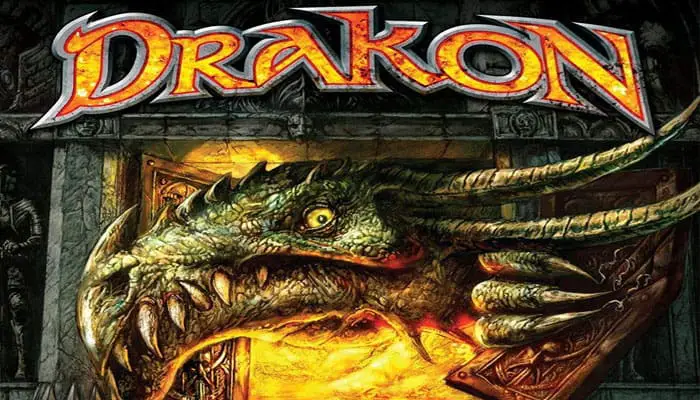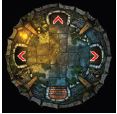
Drakon, the old dragon, has captured a brave band of heroes sneaking into her lair to steal her gold. Rather than eat them immediately, she has decided to make a game of it, and greed shall set one hero free.
She has released the frightened heroes into the entrance of her magical labyrinth, and the first to collect 10 gold from her maze gets to go free. The rest get to be lunch.
In Drakon, two to six players assume the roles of mighty heroes trapped in Drakon's lair. Players place chamber tiles to create the lair, and they move around exploring the lair and collecting coins in order to buy their freedom.

Components
- 6 Hero Figures
- 72 Chamber Tiles
- 28 Coin Tokens
- 1 Drakon Figure
- 6 Hero Cards
- 6 Player Aids
- Instructions
In Drakon, each player controls a hero. In game terms, the word "hero" refers to both the player controlling the hero as well as the in-game hero. As such, "hero" and "player" are used interchangeably.
Object of the Game
Players move around the lair collecting coins from various chambers. When a player collects a coin, he looks at its gold value (the number on the underside) and places it facedown in front of him, keeping it hidden from the other players.
The first player to collect coins with a total gold value of 10 or more immediately wins the game.
Setup
To set up Drakon, perform the following steps in order:

-
Place Entrance Chamber: Find the entrance chamber and place it in the center of the play area.
-
Prepare Draw Pile: Shuffle the remaining tiles and place them facedown in a pile near the play area.
-
Prepare Drakon's Hoard: Place all coins number-side down near the play area and mix them to create Drakon's hoard. Place the Drakon figure near the hoard.
-
Determine First Player: Randomly determine who is the first player.
-
Choose Heroes: In turn order, each player takes one hero card and places it in front of him, text-side down. This card helps players identify who is playing which hero. He also takes the matching figure and places it on the Entrance chamber.
-
Draw Starting Hand: Each player draws four tiles from the draw pile to create his starting hand of tiles.

Game Play
Drakon is played over a series of turns, beginning with the first player and proceeding clockwise. On his turn, the current player performs one action of his choice: either place a chamber or move. After performing his action, his turn ends.
Placing a Chamber

The hero chooses one chamber tile from his hand to play. He must place the chamber adjacent to another chamber already in play, with flat sides touching.
Also, he must orient the incoming chamber so that its arrows do not point at the arrows on any of the adjacent chambers. For examples of legal and illegal chamber placement.
After the hero places his chamber, he draws the top tile from the draw pile.
Examples of placing a Chamber:
The first two examples below show legal chamber placement. The bottom example is illegal because arrows on the two tiles are pointing at each other.

Moving
The hero moves to an adjacent chamber in the direction of an arrow printed on his current chamber.
Many chambers have effects that occur when a hero enters or exits them. Each of these effects is explained on the front side of the player aid. Chamber effects are the primary way that heroes gain coins. For example, when a hero enters a chamber with a Find a Coin icon, he takes one coin from Drakon's hoard.
If a player cannot move, the only action he can perform during his turn is the place a chamber action.
Example of moving:
The hero can move only to the left because there are no arrows pointing in the other directions.

Chamber Effects
Unoccupied chambers do not contain any figures. If a chamber effect states "may" it is optional. Otherwise, the effect is mandatory, and the hero must resolve it if able.
-

Empty Chamber: This chamber does not have a chamber effect, but it has arrows indicating which direction your hero can move. There are chambers with one, two, or three arrows.

Entrance Chamber: This circular chamber is where all heroes begin the game, but it does not have a chamber effect.
The entrance chamber cannot be destroyed by the Destroy a Chamber effect or removed from play by the Switch a Chamber effect, but it can be rotated by the Rotate a Chamber effect. When a hero encounters Drakon, he returns to the entrance chamber.
-

Destroy a Chamber: This chamber effect can divide Drakon's lair into two or more disconnected sections. This effect cannot target the entrance chamber.
-

Escape: This chamber effect can be used to avoid the effects of either Windstorm or Magic Harp.
-

Floating Chamber: When you move this chamber, you also may freely rotate it, but you must place it adjacent to a chamber already in play and in such a way that its arrows do not point at arrows in adjacent chambers. This chamber effect can divide Drakon's lair into two or more disconnected sections.
-

Lose a Coin: If you have zero coins, ignore this effect.
-

Magic Harp: This chamber effect does not force a hero to perform a move action. If you are adjacent to two or more chambers with a Magic Harp icon to which you can legally move, choose which of those chambers to enter.
If you occupy a chamber with either a Master Key or a Teleport icon, you are not required to enter an adjacent chamber with a Magic Harp icon.
-

Mind Control: When moving another hero, you must move him legally, and any chamber effects that occur when that hero is moved from his current chamber still apply.
For example, if the hero occupies a chamber with a Teleport icon, you can move him to any other chamber in play.
-

Rotate a Chamber: You can rotate any chamber, whether it is occupied or unoccupied.
-

Steal a Coin: If the hero you would steal from does not have any coins, ignore this effect.
-

Switch a Chamber: When you place the incoming chamber from your hand, you must orient it so that its arrows do not point at arrows in adjacent chambers. This chamber effect cannot remove the entrance chamber from play.
-

Windstorm: Unless forced to perform a move action (e.g., Mind Control or the Knight's ability), you choose where your hero moves.
If the first chamber you move through has either a Master Key or a Teleport icon, treat it as though it has arrows pointing in all legal directions (where there are no adjacent chambers with arrows pointing back).
If the first chamber you move through has an arrow pointing at an adjacent chamber with a Magic Harp icon, you must enter that chamber. If you cannot move two chambers, you cannot perform a move action. If Drakon occupies the first chamber you move through, you do not encounter Drakon.
Hero Abilities

Abilities on hero cards are used only with the "Heroes!" optional rule (see "Heroes!").
Druid: The Druid can ignore either a chamber effect or an opposing hero's ability that would cause her to lose a coin. The Druid must use her ability before she randomly chooses which of her coins to lose. The Druid cannot use her ability when encountering Drakon.
Knight: When the Knight uses his ability, if there is more than one opposing hero in his current chamber, he chooses one of them to affect.
Ranger: The Ranger can use his ability during the same turn in which he performed a move action.
Sorceress: The Sorceress cannot use her ability to avoid the Magic Harp effect. The Sorceress can use her ability to exit a chamber with a Windstorm icon only if she can move two chambers all at once.
Drakon

When the first Drakon Moves chamber is placed, the current player chooses any unoccupied chamber in play and places the Drakon figure there.
When a hero enters a chamber with the Drakon Drakon Moves Moves icon, that player may move Drakon up to Icon three chambers. Drakon can move in any direction, even against arrows, and she ignores all chamber effects.
Drakon cannot be moved diagonally.
When Drakon moves, she only encounters the heroes in the chamber in which she ends her movement; she does not affect heroes occupying chambers that she moves through.
If a hero enters the chamber currently occupied by Drakon, he does not resolve that chamber's effect before returning to the entrance chamber.
If a hero encounters Drakon on the entrance chamber, he remains in that chamber and randomly returns one of his coins facedown to Drakon's hoard.
While Drakon and any heroes occupy the entrance chamber, if the current hero enters a chamber with the Drakon Moves icon and chooses to move Drakon zero chambers, then all heroes who occupy the entrance chamber encounter Drakon; each affected hero randomly returns one coin facedown to Drakon's hoard.
Encountering Drakon
If a hero ends his turn in the chamber currently occupied by the Drakon figure, or if the Drakon figure ends her movement on a chamber occupied by one or more heroes, those heroes immediately encounter Drakon!
Take all heroes in Drakon's chamber and place them in the entrance chamber. Then, each affected hero randomly returns one of his coins facedown to Drakon's hoard.
Coins

Coins in Drakon's hoard and in front of players remain facedown during the game.
The number on the underside of a coin token is that coin's gold value. A player may discreetly look at his own gold values at any time, being careful not to show any other player.
When a player returns a coin to Drakon's hoard, he places it number-side down and mixes it with the other coins in Drakon's hoard.
Tiles

There is no limit to the number of tiles that a player can have in his hand.
If the draw pile is depleted, players do not draw a tile after placing a chamber.
If a player has zero tiles in his hand, the only action he can perform during his turn is a move action.
If a player has zero tiles in his hand and his hero cannot move, he skips his turn and play proceeds clockwise to the next player.
If all players have zero tiles in their hands and their heroes cannot move, the game immediately ends. Each player flips his coins faceup, and the player with the highest total gold value wins the game.
End of the Game
When a player collects a coin that causes his total gold value to equal 10 or more, he announces that he has won the game and flips his coins faceup to show his opponents.
The game immediately ends and he is declared the winner.
Continue Reading

